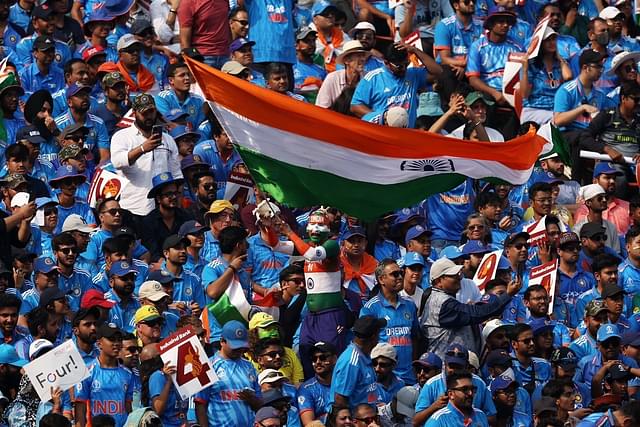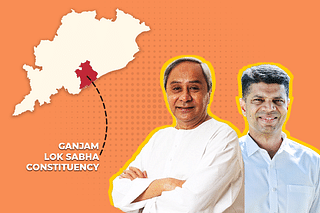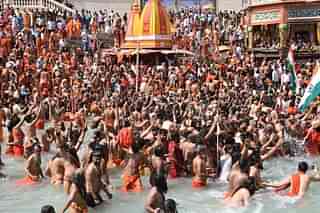Commentary
Is The Indian Cricket Fan At The Stadium The Worst In The World?
K Balakumar
Nov 23, 2023, 05:04 PM | Updated 05:04 PM IST
Save & read from anywhere!
Bookmark stories for easy access on any device or the Swarajya app.

In the aftermath of the World Cup final, in which the host India was roundly beaten by a spirited Australian team, the focus has been trained on the Indian crowds at the stadium in which they apparently come off in less than flattering relief.
There have been a plethora of news reports and opinion pieces that have castigated the Indian fans at the Narendra Modi Stadium on Sunday (19 November) night for being 'disgraceful' and 'shameful'.
So what did the fans do to merit such pejorative epithets?
Did they fight with the police and exchange violent blows, like the visiting Argentine spectators did with the police ahead of the match against Brazil at the Maracana Stadium, on Wednesday morning (IST)?
Or did the crowds show sustained animosity like the Italian fans at Turin exhibited against Novac Djokovic all through the ATP finals tournament last week?
Or possibly they exchanged fierce punches like the fans of San Francisco 49ers and New York Giants at a NFL game last September (one person actually died after the fisticuffs)?
Well, the fans at the stadium on the night of the World Cup final are being taken apart for booing the umpires and also refusing to clap for the Australians' achievement.
To be sure, hooting at the umpires, who did a near perfect job in the finals, was less than edifying. But it can be seen from the prism of the disappointment that home supporters were enduring after India's tepid show in the finals.
It happens all the time when the home team falters on the big stage.
Those who have been to Ashes matches would know the kind of barracking that the visiting team players receive from the host spectators. Some of the things that the crowds at the MCG yell at the English players may well make pirates on sea squirm in squeamishness.
Nobody looks askance at that. Instead it is taken in stride as a response of a typical 'beer-slugging macho Aussie supporter who wears his heart on his sleeve'.
And as far as not clapping for Travis Head's remarkable century, well, again, it is not a new phenomenon confined only to the 'boorish Indian cricket supporters'.
People should go watch what happens at badminton matches in, say, Malaysia or Indonesia, when local players are up against other country rivals. The phrase 'all hell breaks loose' literally comes alive in such situations.
Applauding the achievements of opposite team players is surely welcome and uplifting. But in a world where partisanship is more pronounced than ever, it is just churlish to blame Indian fans alone for biased behaviour.
In any case, fans at the stadium become 'one' as a crowd, and sometimes in such a situation, ideal responses go for a toss.
The philosopher Gustave Le Bon, a pioneer of crowd psychology, has written in detail about the transition of the conscious personalities of individuals into a kind of collective soul that makes them feel completely different — which sometimes implies hysterical and irrational behaviour.
Home Advantage, An Inescapable Reality Of Sports
In sports, teams and individual players are always said to hold an advantage in home matches not just because of knowledge of local conditions, but also due to the fanatical fan support in the arena.
The existence of home advantage due to spectators backing, is well established across sports.
Interestingly, an important study by Nevill and Holder (in 1999) suggested that the crowd may influence officials in subconsciously favouring the home team. That is the power of vocal support in the stands.
In another research, Nevill, Balmer and Williams (2002) assessed whether decisions of qualified referees could be influenced by the noise of the crowd and discovered that indeed was the case.
For instance, Great Britain (GB)'s performance and medals attained at the London 2012, in comparison to Beijing 2008 Olympic Games, is illuminating.
There appears to be dramatic differences in the performances in subjectively judged sports.
In boxing at the 2008 Olympic Games, Team GB was placed sixth with one gold and two bronze medals. However in the London 2012 games, Team GB boxing was ranked first with three gold medals.
The same pattern can be found in gymnastics, another subjectively judged sport. The Beijing 2008 games saw Team GB placed 13th overall with one bronze medal. In London 2012 however, Team GB was 11th with four medals.
This is not to suggest that there was hanky-panky in the way these events were officially judged. This is just to point out that the partisanship of the fans at live sporting events is a given and that is in favour of the home teams.
And the fans at Ahmedabad were no different and don’t deserve the collective outpouring of hate directed at them by some sections.
Actually, the players and teams understand the fans better than the editorial opinionators and op-ed writers, many of whom have hardly visited a stadium in their lifetime.
Australian captain Pat Cummins was in fact pretty much aware of what it would be like in the finals. Ahead of the match, Cummins smartly said, "it will be satisfying to get Indian fans silent in the World Cup final."
To his and his team's greatness, achieved precisely that. The larger point is that, Indian fans going quiet in the event of their team performing under par, was always on the cards.
Good players and teams don't blame the crowds. They, in fact, find motivation to do well in such circumstances when the mood in the stands is against them.
The world number one tennis player Djokovic, who is constantly booed, across stadiums in a variety of countries, usually uses it to cheer himself up.
"They're actually doing me a favor," Djokovic once told Serbian media. "The more they cheer against me, the better off I am. With me, they wake up to something they might not want to see — a winner."
Partisan Fans Are Not A Shame
Partisan sporting crowds is not a national shame and the rest of the country need not slip into a chest-beating threnody in a performative charade.
It is also not an overt spilling of jingoism or nationalism for the home fans to support the home team. It has been part of the sporting lore since the start of history.
Seriously, some of the writing post-finals ripping apart the crowds is funny and agonising simultaneously.
Fans, especially in the excitement-dripping atmosphere of a stadium, are no monks. They let their loyalties show in loudness (and in its absence). Being emotional in such situations is actually reasonable.
"There is this idea that reason and emotion have nothing to do with one another, and that being emotional is a hindrance to being rational. This idea needs to be challenged,” says Gerhard Thonhauser who studied in depth the behaviour of spectators at sports events.
"Emotions can tell us something about a situation and how we feel about it. That is not irrational, but a normal aspect of our interactions. Even a rational exchange has an affective grounding," he said.
The larger point is, blame the Board of Control for Cricket in India (BCCI) for its hubris and the way it conducts its affairs. It is understandable and right.
Criticise the team for regularly underperforming in clutch games at high-stakes ICC events — India hasn't won anything of note since 2013. It is inevitable after another such loss.
But to come down on the Ahmedabad crowds for bringing disrepute to the nation's sporting ethos is both motivated and erroneous.
Don't forget that the fans in Calcutta burned things in the stands when India faltered in the semi-finals against Sri Lanka in the 1996 World Cup.
And the Test against Pakistan in February 1999 was flubbed by crowd trouble so much so, that when it ended there was total silence, "watched by a few officials, VIPs, journalists and police, after the crowd was forcibly expelled."
Compared to those shenanigans, the Ahmedabad fans actually behaved saintly. They merely spoke with their silence.
Save & read from anywhere!
Bookmark stories for easy access on any device or the Swarajya app.
Support Swarajya's 50 Ground Reports Project & Sponsor A Story
Every general election Swarajya does a 50 ground reports project.
Aimed only at serious readers and those who appreciate the nuances of political undercurrents, the project provides a sense of India's electoral landscape. As you know, these reports are produced after considerable investment of travel, time and effort on the ground.
This time too we've kicked off the project in style and have covered over 30 constituencies already. If you're someone who appreciates such work and have enjoyed our coverage please consider sponsoring a ground report for just Rs 2999 to Rs 19,999 - it goes a long way in helping us produce more quality reportage.
You can also back this project by becoming a subscriber for as little as Rs 999 - so do click on this links and choose a plan that suits you and back us.
Click below to contribute.





